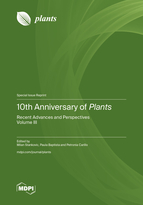10th Anniversary of Plants—Recent Advances and Perspectives
A special issue of Plants (ISSN 2223-7747).
Deadline for manuscript submissions: closed (30 June 2022) | Viewed by 323377
Special Issue Editors
Interests: plant science; plant biology; plant ecology
Special Issues, Collections and Topics in MDPI journals
Interests: plant microbiome; microbe-induced plant tolerance to stresses; endophyte; sustainable agriculture
Special Issues, Collections and Topics in MDPI journals
Interests: role of compatible osmolytes in stress responses; plant metabolic profiling; regulation of carbon and nitrogen metabolism; effects of biostimulants on plant metabolism
Special Issues, Collections and Topics in MDPI journals
Special Issue Information
Dear Colleagues,
Published for the first time in 2012, Plants will celebrate its 10th anniversary. When the inaugural issue was launched, Plants had already published nearly 3500 papers and reflected the diversity and richness of research in the field of Plant science. To mark this significant milestone and celebrate the achievements made throughout the years, we intend to publish a Special Issue entitled "10th Anniversary of Plants—Recent Advances and Perspectives”. In the past decade, the continuous support of the authors, editors, reviewers, as well as the readers, has resulted in noteworthy success and the achievement of a common goal, as well as the sustained reputation of the Plants in the world of science. In parallel with the development of our journal, great success, too, has been recorded across the field of Plant science itself, from the molecular to the ecosystem level, and many new findings are based on new methodological approaches. For these reasons, we want to realize a Special Issue to honor the collective efforts of all those who have contributed so far to the the success of the journal and the gathering of scientific aspects in Plant sciences related to current challenges and future innovation. Apart from the fact that this Special Issue will remain as a celebration of the anniversary, it should also serve as a guide for new discoveries in Plant science and thus for the development of the Journal. Based on all the above, I am honored to announce that top experts in this field will be encouraged to contribute papers to this Special Issue.
Dr. Milan Stankovic
Prof. Dr. Paula Baptista
Prof. Dr. Petronia Carillo
Guest Editors
Manuscript Submission Information
Manuscripts should be submitted online at www.mdpi.com by registering and logging in to this website. Once you are registered, click here to go to the submission form. Manuscripts can be submitted until the deadline. All submissions that pass pre-check are peer-reviewed. Accepted papers will be published continuously in the journal (as soon as accepted) and will be listed together on the special issue website. Research articles, review articles as well as short communications are invited. For planned papers, a title and short abstract (about 100 words) can be sent to the Editorial Office for announcement on this website.
Submitted manuscripts should not have been published previously, nor be under consideration for publication elsewhere (except conference proceedings papers). All manuscripts are thoroughly refereed through a single-blind peer-review process. A guide for authors and other relevant information for submission of manuscripts is available on the Instructions for Authors page. Plants is an international peer-reviewed open access semimonthly journal published by MDPI.
Please visit the Instructions for Authors page before submitting a manuscript. The Article Processing Charge (APC) for publication in this open access journal is 2700 CHF (Swiss Francs). Submitted papers should be well formatted and use good English. Authors may use MDPI's English editing service prior to publication or during author revisions.









